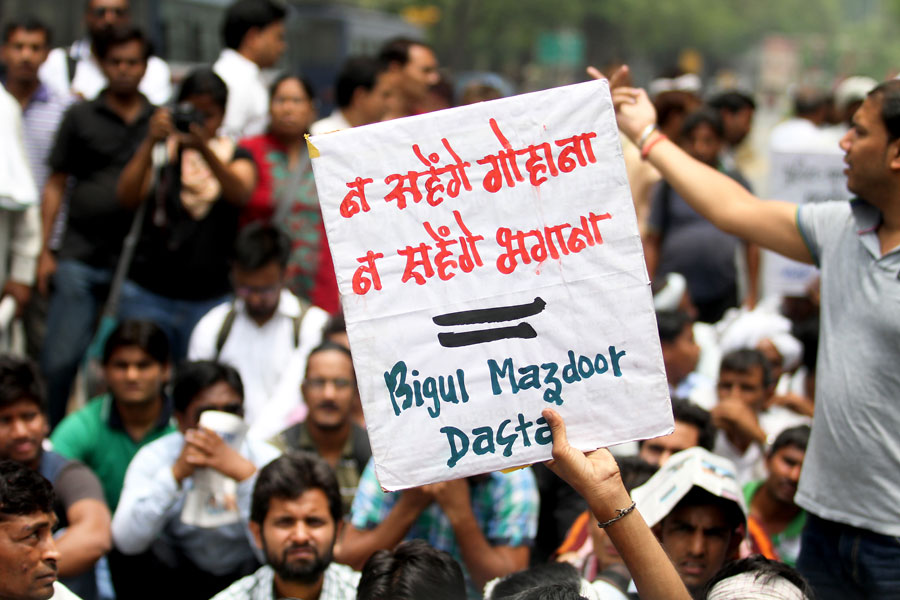
Celebrating Dalit History – The Resistance of Bhagana’s Dalits
In March 2014, four Dalit girls and women were kidnapped and gang-raped by members of the dominant Jat caste in Bhagana village in Haryana. Rakesh Panghal, the village head, and a Jat, condoned the atrocity, claiming, ‘it was a consensual act’; many of his relatives were involved. The youngest survivor was 13.
The violence against Dalit women constituted a critical aspect of the backlash by the economically and socially powerful Jats against the assertion of rights by Bhagana’s Dalits, the majority of whom were and still are landless labourers. Jats in Haryana claim to the disproportionate property, privilege, and power — and thus the very fabric and content of Jat lifestyles and lives, and sense of collective and individual self — fundamentally rest on and crucially necessitate the continuation of Caste, by any means necessary. In 2012, after a group of Dalit families filed a written complaint to the district administration for being excluded from Bhagana’s redistribution of common land, Bhagana’s Jats organized a highly-coordinated and violent campaign to intimidate the village’s entire Dalit community. Condoned and assisted by village authorities, Jats prevented Dalits from accessing basic services and, buying groceries, and using the village pond; they further boycotted Dalit shops and services, divided the Dalit ‘playground’ (a communal space and gathering point) into small plots, and constructed a brick wall blocking access to Dalit homes — illustrating just some of the methods historically used by the dominant Castes to curb Dalit autonomy and discipline Dalit resistance. In effort to both flee persecution and call national attention to their plight, 137 Dalit families left their homes and marched to the nation’s capital that year.
The families set up camp outside of the Indian Parliament in New Delhi and were joined a year later by 90 additional Dalit families after 2014 gang-rape. Protesters organized to demand justice against Caste-based violence, including action against the rape perpetrators, and compensation for the survivors. Many families hung portraits of Dalit leaders Babasaheb and Phule in their tents, as well as pictures from other protests condemning violence against Dalits. At a candle-light procession of 200 people, one protestor claimed: ‘India is a free country. Everyone is free. Why should we remain slaves?’
Although Yogendra Yadav ( then of the Aam Aadmi Party) visited the protest camp, while Udit Raj (aligned with the BJP) sent ‘assurances,’ the State government of Haryana ignored the plight of Bhagana’s Dalits, and did not respectfully engage with their grievances.
In August 2015, nearly 100 Dalit families — some of whom had been living in makeshift protest camps outside of India’s Parliament for nearly four years — converted to Islam in a ceremony at Jantar Mantar, New Delhi, one day after meeting with Chief Minister Manohar Lal Khattar. The failure of the State to address Dalit concerns, compounded by the persecution and humiliation of Caste, led to the community’s continued disenchantment towards Hinduism and the Indian State, and their embrace of Islam.
As Dalit leader, Virender Bagoria, noted: ‘Our four-year-old struggle to get justice failed to bear any result. The administration and society have let us down.’ Satish Kajlaa, Dalit protestor, who camped outside of India’s parliament for four years, shared, ‘Through our struggle and our education, we have realized that the root cause of all the discrimination towards us is the Hindu religion.’
The histories, lives, and resistance of the Dalit people of Bhanaga led the community to see the ways Brahminical Supremacy is justified and normalized as ‘Hinduism;’ and further veiled, made palatable, and empowered through the modern state apparatus of ‘secular and democratic’ India.
The conversion of Bhagana’s Dalit families to Islam was an act of Dalit resistance, and part of a greater history of conversion in the Subcontinent as an attempt to escape Caste (see DHM Post: Dhamma Chakra Pravartan Din, Meenakshipuram: Islam as Liberation). Today, the vast majority of India’s religious minorities claim Caste-oppressed lineage.
The histories of conversion of South Asia’s Muslims critically contextualize the present-day ghettoization of India’s Muslims and the highly visible persecution they face under Modi, the historic desire for Pakistan as well as the occupation and liberation movement of Muslim-majority Kashmir.
Our histories of conversion as acts of resistance against Brahminical Supremacy challenge the popular and dangerous false-narrative that the Subcontinent’s Muslims are descendants of foreign invaders; as well as the equally popular and equally dangerous false-narrative of ‘communalism,’ which assumes that India’s Hindus and Muslims are equally-positioned, and thus equally vulnerable and accountable to past and present-day violence.
THIS POST WAS WRITTEN FOR DALIT HISTORY MONTH BY NATASHA DAR.
From – Dalit History Month Collective




+ There are no comments
Add yours